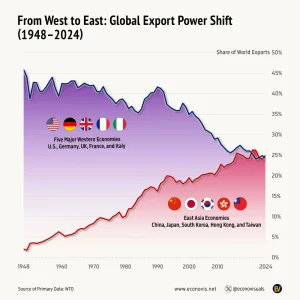The global economic landscape has undergone a dramatic transformation over the past seven decades, with the balance of export power shifting decisively from West to East. In 1948, five major Western economies—the U.S., Germany, the UK, France, and Italy—dominated global trade, accounting for 45.8% of world exports. Meanwhile, five East Asian economies—China, Japan, South Korea, Hong Kong, and Taiwan—represented a mere 2.1%. Fast forward to 2024, and East Asia has not only caught up but surpassed the West in export volume, marking a historic rebalancing of economic influence.
This article explores the data behind this shift, its driving forces, and what it means for the future of global trade.

Credit: Voronoi
The Rise and Decline of Western Export Dominance
Post-War Western Hegemony (1948–1980s)
In the aftermath of World War II, Western economies were the undisputed leaders of global trade:
-
1948: The five Western nations exported $26.8 billion (45.8% of global exports).
-
1950s–1980s: Their share remained stable at around 40%, bolstered by reconstruction, industrialization, and technological advancements.
The Decline Begins (1990s–2024)
From the 1990s onward, the West’s share began to erode:
-
1990: 41.7% of global exports.
-
2012: 26.0%.
-
2024: 24.3% ($5.9 trillion).
Key Factors:
-
Offshoring and Globalization: Western companies moved manufacturing to Asia to cut costs.
-
Rise of Services: Western economies shifted toward service-based industries, reducing goods exports.
-
Economic Stagnation: Slow growth in Europe and wage stagnation in the U.S. limited export competitiveness.
–
The East Asian Export Miracle
From Marginal to Major Player (1948–2024)
East Asia’s ascent has been nothing short of remarkable:
-
1948: $1.2 billion (2.1% of global exports).
-
2024: $6.1 trillion (24.9%), narrowly surpassing the West.
Drivers of Growth:
-
China’s Economic Boom: Since its 1978 reforms, China became the “world’s factory,” accounting for 15% of global exports by 2024.
-
Japan and the Tigers: Japan’s post-war industrialization, followed by South Korea, Taiwan, and Hong Kong’s export-led models, laid the groundwork.
-
Supply Chain Integration: East Asia developed unmatched efficiency in manufacturing and logistics.
Key Milestones
-
2001: China joined the WTO, accelerating its export surge.
-
2020: East Asia overtook the West in total export volume for the first time.
–
The Bigger Picture: A Zero-Sum Game?
Despite the shift, the combined share of these ten economies has remained around 50% of global exports since the 1950s. This suggests:
-
Relative Decline, Not Collapse: The West’s share fell, but its absolute export volume grew (just at a slower pace).
-
Global Trade Expansion: Emerging markets (e.g., India, Vietnam) are gaining ground, but East Asia and the West still dominate.
–
Future Perspectives
-
China’s Slowdown: Demographic challenges and trade tensions could dampen growth, but its export infrastructure remains robust.
-
Reshoring Trends: Western nations may bring back some production, but full reversal is unlikely.
-
New Contenders: India and Southeast Asia could replicate East Asia’s success, further diversifying global trade.
-
Tech and Green Exports: The next battleground may be high-tech and renewable energy exports, where both regions compete.
–
FAQ
Q: Which country contributed most to East Asia’s rise?
A: China, whose exports grew from negligible in 1948 to $3.6 trillion (15% of global exports) in 2024.
Q: Did the West’s absolute export volume decline?
A: No, it grew—but East Asia’s grew much faster. The West’s share shrank due to relative decline.
Q: Will East Asia’s dominance continue?
A: Likely, though challenges like aging populations and protectionism could slow growth.
Q: What role did globalization play?
A: Critical. Free trade agreements and supply chain integration enabled East Asia’s export boom.
–
Conclusion
The data reveals a seismic shift in global economic power from West to East. While the five major Western economies once commanded nearly half of world exports, East Asia’s relentless growth has rewritten the rules of trade. Yet this isn’t a story of Western decline so much as Eastern ascent—a testament to the transformative power of industrialization, globalization, and economic policy.
As we look ahead, the key question isn’t just “Who leads in exports?” but “What comes next?” The next chapter of global trade will likely be shaped by technology, sustainability, and geopolitical realignments, with both regions vying for supremacy in an increasingly multipolar world.
Reference: https://www.voronoiapp.com/trade/-From-West-to-East-Global-Export-Power-Shift-19482024-5238
Sources: WTO, Econovis.net
Visual Credit: @econovisuals


thank you